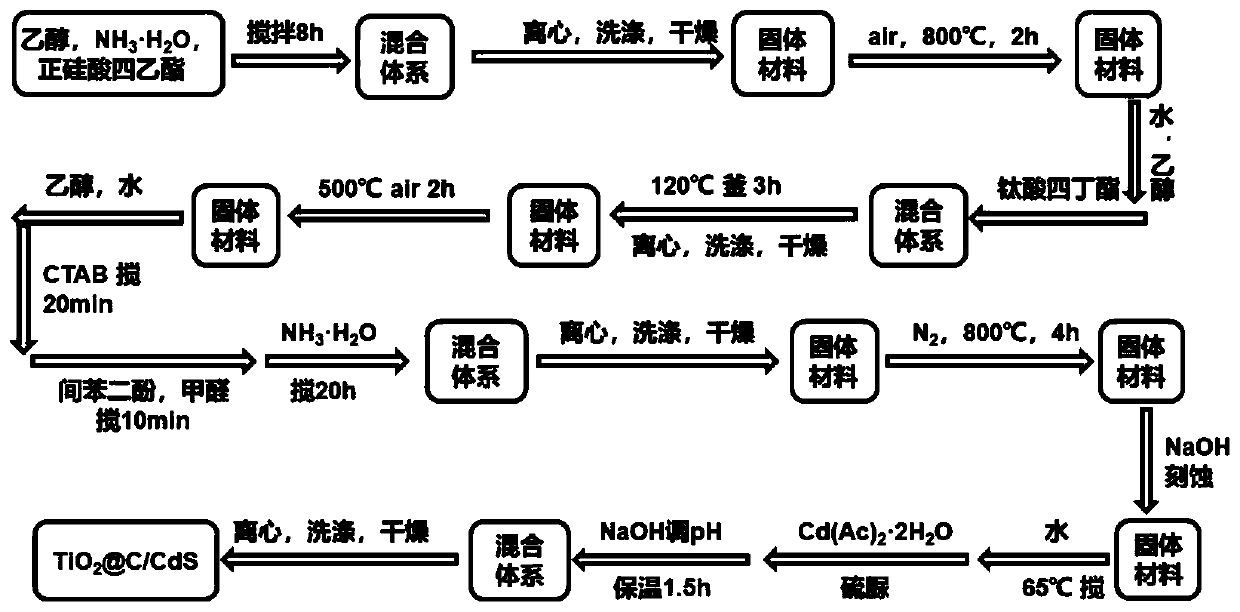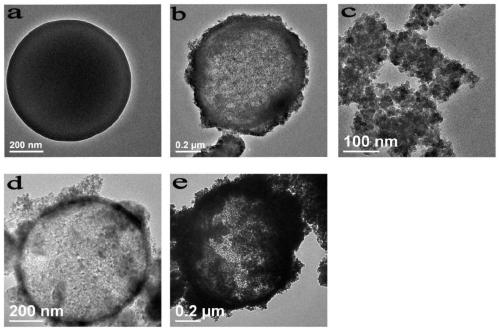TiO2@C/CdS composite material and preparation method thereof
A composite material, in-situ composite technology, applied in chemical instruments and methods, water/sludge/sewage treatment, chemical/physical processes, etc. Low utilization rate and other problems, to achieve the effect of cost saving and excellent photocatalytic performance
- Summary
- Abstract
- Description
- Claims
- Application Information
AI Technical Summary
Problems solved by technology
Method used
Image
Examples
Embodiment 1
[0034] In the first step, ethanol, tetraethyl orthosilicate and NH 3 ·H 2 O was mixed at a volume ratio of 10:1:4, and magnetically stirred at room temperature for more than 8 hours;
[0035] In the second step, after the precipitate obtained in the first step is centrifugally washed and dried, the temperature is raised to 800°C at a rate of 5°C / min and then calcined for 2 hours to obtain SiO 2 nanospheres;
[0036]In the third step, 100 mg of the sample obtained in the second step was ultrasonically dispersed in deionized water and ethanol solution (volume ratio 1:37), and 0.6 mL of tetrabutyl titanate was added to it, stirred magnetically, transferred to a kettle, and kept at 120°C for 3 hours;
[0037] The fourth step is to take the kettle, cool it down naturally, wash and dry the product by centrifugation, then raise the temperature to 500°C at a rate of 5°C / min and then calcinate for 2 hours to obtain SiO 2 @TiO 2 core-shell structure;
[0038] In the fifth step, 200...
Embodiment 2
[0044] In the first step, ethanol, tetraethyl orthosilicate and NH 3 ·H 2 O was mixed at a volume ratio of 10:1:4, and magnetically stirred at room temperature for more than 8 hours;
[0045] In the second step, after the precipitate obtained in the first step is centrifugally washed and dried, the temperature is raised to 800°C at a rate of 5°C / min and then calcined for 2 hours to obtain SiO 2 nanospheres;
[0046] In the third step, 100 mg of the sample obtained in the second step was ultrasonically dispersed in deionized water and ethanol solution (volume ratio 1:37), and 0.6 mL of tetrabutyl titanate was added to it, stirred magnetically, transferred to a kettle, and kept at 120°C for 3 hours;
[0047] The fourth step is to take the kettle, cool it down naturally, wash and dry the product by centrifugation, then raise the temperature to 500°C at a rate of 5°C / min and then calcinate for 2 hours to obtain SiO 2 @TiO 2 core-shell structure;
[0048] In the fifth step, 20...
Embodiment 3
[0054] In the first step, ethanol, tetraethyl orthosilicate and NH 3 ·H 2 O was mixed at a volume ratio of 10:1:4, and magnetically stirred at room temperature for more than 8 hours;
[0055] In the second step, after the precipitate obtained in the first step is centrifugally washed and dried, the temperature is raised to 800°C at a rate of 5°C / min and then calcined for 2 hours to obtain SiO 2 nanospheres;
[0056] In the third step, 100 mg of the sample obtained in the second step was ultrasonically dispersed in deionized water and ethanol solution (volume ratio 1:37), and 0.6 mL of tetrabutyl titanate was added to it, stirred magnetically, transferred to a kettle, and kept at 120°C for 3 hours;
[0057] The fourth step is to take the kettle, cool it down naturally, wash and dry the product by centrifugation, then raise the temperature to 500°C at a rate of 5°C / min and then calcinate for 2 hours to obtain SiO 2 @TiO 2 core-shell structure;
[0058] In the fifth step, 20...
PUM
 Login to View More
Login to View More Abstract
Description
Claims
Application Information
 Login to View More
Login to View More - R&D
- Intellectual Property
- Life Sciences
- Materials
- Tech Scout
- Unparalleled Data Quality
- Higher Quality Content
- 60% Fewer Hallucinations
Browse by: Latest US Patents, China's latest patents, Technical Efficacy Thesaurus, Application Domain, Technology Topic, Popular Technical Reports.
© 2025 PatSnap. All rights reserved.Legal|Privacy policy|Modern Slavery Act Transparency Statement|Sitemap|About US| Contact US: help@patsnap.com



